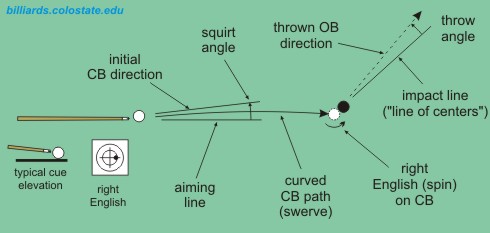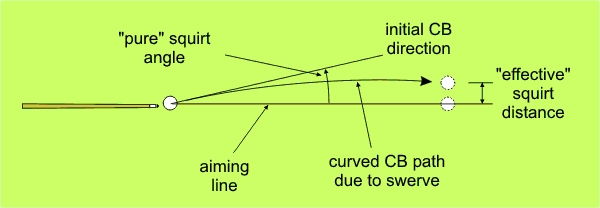What is squirt (CB deflection) and how is it different from swerve (CB curve)?
From the online glossary:
squirt (AKA “cue ball deflection”): angular displacement of the cue ball’s path away from the cue stroking direction caused by the use of sidespin.
swerve: curve of the cue ball’s path while sliding due to cue elevation and sidespin.
cue ball deflection: same as “squirt;” also sometimes used to describe the net effect of squirt and swerve (AKA “squerve” or “effective squirt” or “net cue ball deflection”).
net cue ball deflection (AKA “squerve” or “effective squirt”): the net effect of “squirt” and “swerve” (i.e., the cue ball deflection off the aiming line at object ball impact).
effective squirt (AKA “squerve”): same as “net cue ball deflection.”
Total or net or effective CB deflection is the end result of of both squirt (sometimes also called “deflection”) and swerve. Throw also affects some shots (some more than others). A complete summary and demonstration of all squirt, swerve, and throw effects can be found here:
complete summary of all squirt, swerve, and throw effects (with supporting resources)
Squirt depends on the amount of sidespin used and the properties (endmass) of the shaft. Swerve depends on shot speed, shot distance, the amount of sidespin, cue elevation, and ball/cloth conditions. See the effects summary resource page for explanations and demonstrations. Vertical tip position (for draw and follow) also affect squirt and swerve. For more info, see: squirt and swerve draw and follow effects. Again, net CB deflection is a result of the combined effects of squirt and swerve.
Here are some video demonstrations and explanations of squirt, swerve, and throw:
- NV A.17 – Effective squirt vs. speed
- NV B.1 – Mike Page’s squirt and swerve video
- NV B.70 – Squirt, swerve, and throw, from VEPS II
- NV B.86 – Cut-induced throw (CIT) and spin-induced throw (SIT), from VEPS IV
How can you predict the directions and amounts of squirt, swerve, and throw with various types of shots?
Here’s Diagram 3 from “Squirt – Part I: introduction” (BD, August, 2007) that shows all of the effects involved with using sidespin:

Some people might think the throw direction in the diagram is wrong due to cut-induced throw (CIT). Think about it yourself and decide if you think the diagram is correct or not. Many people seem to be confused by the separate effects of squirt and swerve. Diagram 4 from the article helps clarify things:

The phrase “effective squirt” or “net cue ball deflection” is used for the combined effects of both squirt and swerve. The term “squerve” (SQUirt + swERVE) means the same thing. For more information, demonstrations, and details, see the complete squirt, swerve, and throw effects resource page. Here’s a video excerpt from Vol. II of the Video Encyclopedia of Pool Shots that explains and demonstrates things:
Now back to Diagram 3. Throw direction depends on the direction of the relative motion of the surface of the cue ball in contact with the object ball. This direction is affected by both cut angle and spin. “Throw – Part VI: inside/outside english” (BD, January, 2007) and “Throw – Part VII: CIT/SIT combo” (BD, February, 2007) illustrate the different possibilities quite well. The throw direction shown in Diagram 3 of “Squirt – Part I: introduction” (BD, August, 2007) is appropriate given the amount of english.
Object ball throw depends on cut angle, shot speed, type and amount of english, and the amount of vertical plane spin (draw, follow, stun). The following series of instructional articles elaborate on all of these factors:
- “Throw – Part I: introduction” (BD, August, 2006).
- “Throw – Part II: results” (BD, September, 2006).
- “Throw – Part III: follow and draw effects” (BD, October, 2006).
- “Throw – Part IV: spin-induced throw” (BD, November, 2006).
- “Throw – Part V: SIT speed effects” (BD, December, 2006).
- “Throw – Part VI: inside/outside english” (BD, January, 2007).
- “Throw – Part VII: CIT/SIT combo” (BD, February, 2007).
- “Throw – Part VIII: spin transfer” (BD, March, 2007).
- “Throw – Part IX: spin transfer follow-up” (BD, April, 2007).
- “Throw – Part X: the big picture” (BD, May, 2007).
- “Throw – Part XI: everything you ever wanted to know about throw” (BD, June, 2007).
- “Throw – Part XII: calibration, and hold shots” (BD, July, 2007).
Cut-induced throw (CIT) and spin-induced throw (SIT) are just different names for throw, depending upon the primary cause of the throw, but the effects don’t really combine as separate factors.
Dr. Dave keeps this site commercial free, with no ads. If you appreciate the free resources, please consider making a one-time or monthly donation to show your support:
